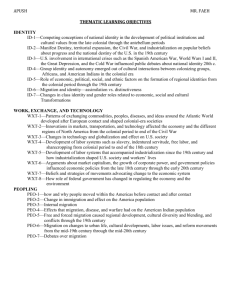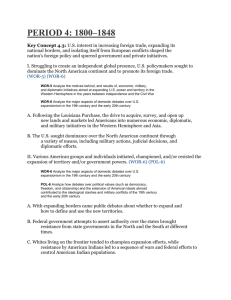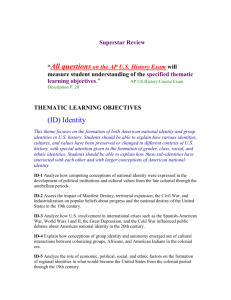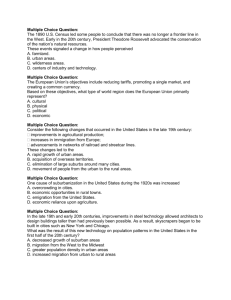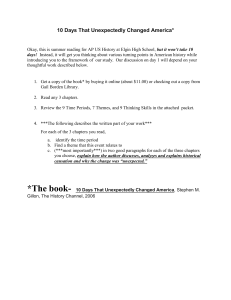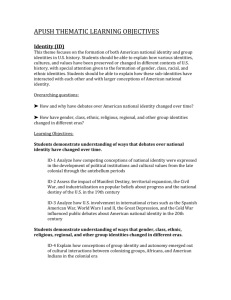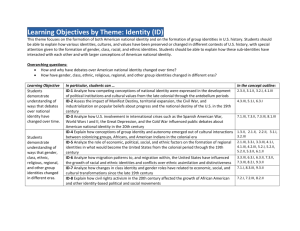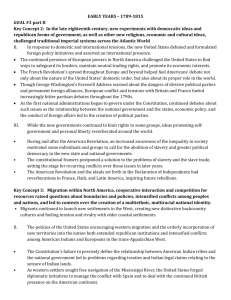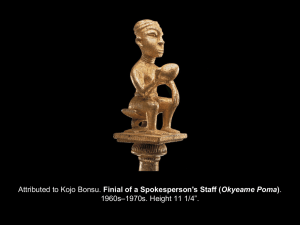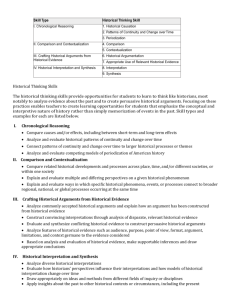Overview of the new AP US History course
advertisement
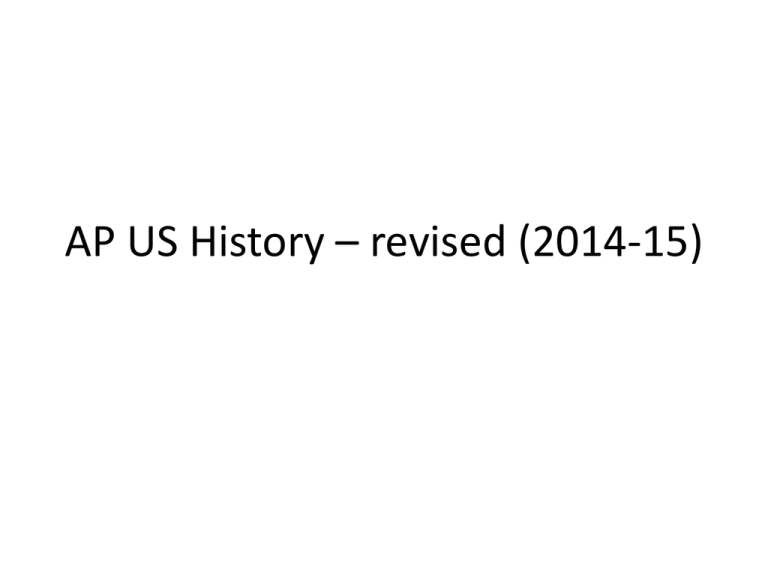
AP US History – revised (2014-15) • Beginning with the 2014-15 school year, the Advanced Placement US History course format has changed. Prior to 2014, students focused their studying on past events, facts, names, dates, laws, etc. These were often highlighted in the textbook and were the focal point of course. • The new (revised) AP US History course and test is different in some ways. Students will now spend less effort with memorization and more focus on the interpretation of history by an author and the evidence behind it. • Historian, High School teacher and College Professor Carl Schulkin summarized AP US History best with the following: “As both a historian and teacher, I have always stressed to my students that history is fundamentally and inevitably interpretive, that the first step in studying history is learning how to identify an author’s interpretation. The second, I have consistently emphasized, is locating the author’s evidence and then comparing his/her interpretation with the evidence—the author’s own and that gathered from outside sources. Only then can a student decide whether an author’s interpretation is or is not well supported by the available evidence.” • Beginning in 2014-15, students will also be asked to identify Historical Thinking Skills and be able to recognize and apply those skills on the test. • Additionally, students will learn Thematic Learning Objectives which the students will be required to know by the end of the course which outline seven major themes to show historical understanding. • Finally, students will be required to know historical milestones (significant events in US History) which will be outlined in the Concept Outline. The Concept Outline divides US History into nine historical periods. Historical Thinking Skills Students need to learn to identify which of these historical thinking skills or historical argumentation or appropriate use of historical evidence is being tested in an exam question • • • • • • • • • 1. 2. 3. 4. 5. 6. 7. 8. 9. Historical Causation Patterns of Continuity and Change over Time Periodization Comparison Contextualization Historical Argumentation Appropriate Use of Relevant Historical Evidence Interpretation Synthesis Historical Thinking Skills • 1. Historical Causation -- “identify, analyze, and evaluate the relationships among multiple historical causes and effects, distinguishing between those that are long-term and immediate, and among coincidence, causation and correlation;” – Ex. – The Civil Rights Era 1950’s – 60’s • 2. Patterns of Continuity and Change over Time -- “recognize, analyze, and evaluate the dynamics of historical continuity and change over periods of time of varying lengths, as well as the ability to relate these patterns to larger historical processes or themes;” – Ex. – discrimination against immigrants over time • 3. Periodization -- “describe, analyze, evaluate, and construct models that historians use to organize history into discrete periods,” identifying turning points and recognizing the significance of the choice of specific beginning and ending dates; identify milestones – Ex. – The Progressive Era (Presidency of T. Roosevelt) Historical Thinking Skills cont. • 4. Comparison -- “describe, compare, and evaluate multiple historical developments within one society, one or more developments across or between different societies, and in various chronological and geographical contexts,” – How did the term ‘Conservatism’ change from the 1920’s, 50’s, and 80’s • 5. Contextualization -- “connect historical events and processes to specific circumstances of time and place and to broader regional, national, or global processes.” – US Foreign policy since the end of WWI (The first 5 Historical Thinking Skills are the most common and should be understood first) Historical Thinking Skills cont. • 6. Historical Argumentation -- “the ability to identify, describe, and evaluate evidence about the past from diverse sources…with respect to content, authorship, purpose, format, and audience.” – Ex. – Causes of the Civil War based on a Northern and a Southerner’s opinion • 7. Appropriate Use of Relevant Historical Evidence -- “the ability to identify, describe, and evaluate evidence about the past from diverse sources…with respect to content, authorship, purpose, format, and audience.” – United States involvement into Imperialism Historical Thinking Skills cont. • 8. Interpretation -- the ability to describe, analyze, evaluate, and create diverse interpretations of the past — as revealed through primary and secondary historical sources — by analyzing evidence, reasoning, contexts, points of view, and frames of reference.” -- Ex. -- Interpreting the need for slavery • 9. Synthesis -- defined as “the ability to develop meaningful and persuasive new understandings of the past by applying all of the other historical thinking skills, by drawing appropriately on ideas and methods from different fields of inquiry or disciplines, and by creatively fusing disparate, relevant, and sometimes contradictory evidence from primary and secondary works.” – Ex. The ability to demonstrate an understanding of any event in US History by utilizing proper evidence Defining the Course Period • 1 • 2 • 3 Early Contacts Among Groups in North America 1491-1607 N. American Societies in the Context of the Atlantic World 1607-1754 Birth of a New Nation and Struggle for Identity 1754-1800 • 4 Growing Pains of the New Republic • 5 • 6 • 7 Expansion, Regional Separation, the Civil War and Its Aftermath 1844-1877 • 8 Increasing Prosperity and Global Responsibility After World War II 1945-1989 • 9 Globalization and Redefining National Identity 1980-Today 1800-1848 Industrialization, Urbanization, and Cultural Transformation 1865-1914 Domestic and Global Challenges and the Creation of Mass Culture 1890-1945 Thematic Learning Objectives • Identity • • ID-1 Competing Conceptions of National Identity, late colonial-antebellum ID-2 Impact of Manifest Destiny, territorial expansion, Civil War and industrialization on beliefs about progress and national destiny, 19th century ID-3 Influence of U.S. involvement in Spanish-American War, World Wars I and II, Great Depression and Cold War on public debates about national identity, 20th century • • • • ID-4 How Conceptions of Group Identity emerged out of cultural interactions between colonizing groups, Africans and American Indians, colonial era ID-5 Role of economic, social, political and ethnic factors in formation of regional identities, colonial period through 19th century ID-6 How migration has influenced the growth of racial and ethnic identities and conflicts over ethnic assimilation and distinctiveness, periods 3-9 ID-7 How changes in class identity and gender roles have related to economic, social and cultural transformations, since the late 19th century ID-8 How civil rights activism in the 20th century affected the growth of identity-based political and social movements • Work, Exchange and Technology • WXT-1 How patterns of exchanging commodities, peoples, diseases and ideas developed around the Atlantic World and shaped North American colonial societies, periods 2-3 WXT-2 How innovations in markets, transportation and technology affected the economy and different regions, 1607-1865 WXT-3 How changes in transportation, technology and integration of U.S. economy into world markets have influenced U.S. Society since 1865 WXT-4 Development of labor systems such as slavery, indentured servitude and free labor to the end of the 18th century WXT-5 Development, persistence and change in labor systems since 1800 and how Civil War and industrialization shaped U.S. society and workers’ lives WXT-6 How arguments about market Capitalism, the growth of corporate power and government policies influenced economic policies, periods 3-7 WXT-7 Compare beliefs and strategies of movements advocating changes to the U.S. economic system, particularly organized labor, Populist and Progressive Movements WXT-8 How and why the role of government in regulating economic life and the environment has changed since the end of the 19th century • • • • • • • • • • Thematic Learning Objectives • Peopling • • PEO-1 How and why people moved within the Americas and to and within the Americas, periods 1-2 PEO-2 How changes in the numbers and sources of international migrants altered social and ethnic makeup of U.S. in 19th and 20th centuries PEO-3 Causes and effects of internal migration (urbanization, suburbanization, westward movement, Great Migration) in 19th and 20th centuries • • • • • PEO-4 Effects of migration, diseases and warfare on American Indian population, pds 1-6 PEO-5 How free and forced migration caused regional development, cultural diversity and blending and political and social conflict, periods 1-6 PEO-6 Role of internal and international migration on changes to urban life, cultural developments, labor issues and reform movements, mid-19th through mid-20th century PEO-7 How and why debates over immigration have changed since turn of 20th century • Politics and Power • POL-1 Factors behind competition, cooperation and conflict among different societies and social groups during colonial period POL-2 How and why major party systems and political alignments have arisen and changed, early Republic through end of 20th century POL-3 How activist groups and reform movements (antebellum reformers, civil rights activists, social conservatives) have caused changes to state institutions and society, pds 4-9 POL-4 How and why the New Deal, the Great Society and the modern conservative movement sought to change the role of the federal government, periods 7-9 POL-5 How arguments about meaning and interpretation of the Constitution have affected U.S. politics since 1787 POL-6 How debates over political values (democracy, freedom, citizenship) and extension of American ideals abroad contributed to ideological clashes and military conflict, 19th-early 20th century POL-7 How debates over civil rights and civil liberties have influenced political life since the early 20th century • • • • • • • Thematic Learning Objectives • America in the World • WOR-1 How imperial competition and exchange of commodities influenced patterns of development of North American societies in the colonial period WOR-2 How exchange of ideas among different parts of Atlantic World shaped belief systems and independence movements into early 19th century WOR-3 How growing interconnection of U.S. with worldwide economic, labor and migration systems affected U.S. society since late 19th century WOR-4 How U.S. involvement in global conflicts in 20th century set stage for domestic social changes • • • • • • • WOR-5 Motives behind and results of economic, military and diplomatic initiatives for U.S. expansion in Western Hemisphere between independence and the Civil War WOR-6 Major aspects of domestic debates over U.S. expansionism, 19th and early 20th century WOR-7 Goals of U.S. policymakers in major international conflicts (Spanish-American War, World Wars I and II, Cold Wars) and how U.S. involvement altered role in world affairs WOR-8 How U.S. military and economic involvement in developing world and issues such as terrorism and economic globalization have changed U.S. foreign policy goals since mid-20th century Thematic Learning Objectives • • • • • • • • Environment and Geography—Physical and Human ENV-1 How the introduction of new plants, animals and technologies altered the natural environment and affected the interaction among various groups in the colonial period ENV-2 How the natural environment contributed to regional group identities, institutions and conflicts, precontact through independence ENV-3 Role of environmental factors in regional economic and political identities in the 19th century and how they affected conflicts such as the Revolution and the Civil War ENV-4 How the search for economic resources affected social and political developments from the colonial period through Reconstruction ENV-5 How and why debates about the use of natural resources and the environment have changed since the late 19th century • Ideas, Beliefs and Culture • CUL-1 Compare the cultural values of different European, African American and native peoples and explain intergroup relationships and conflict in the colonial period CUL-2 How emerging conceptions of national identity and democratic ideals shaped value systems, gender roles and cultural movements in the late 18th and 19th centuries CUL-3 How cultural values and artistic expression changed in response to Civil War and postwar industrialization CUL-4 How changing religious ideals, Enlightenment beliefs and republican thought shaped politics, culture and society, colonial era through early Republic CUL-5 Ways that philosophical, moral and scientific ideas were used to defend and challenge the dominant economic and social order in 19th and 20th centuries CUL-6 Role of culture and the arts in 19th and 20th century movements for social and political change CUL-7 How and why “modern” cultural values and popular culture have grown since the early 20th century and affected American politics and society • • • • • • • • • • • • • • • • • • • • • • • • • • • • • • • • • • Concept Outline the Columbian Exchange diverse patterns of colonization British-American system of slavery a rigid racial hierarchy indentured servants belief in British racial and cultural superiority enslaved black people in perpetuity dehumanizing aspects of slavery regional differences The New England colonies Puritans Chesapeake colonies British islands in the West Indies the Pueblo Revolt emergence of racial stereotyping development of strict racial categories accustomed to a large measure of autonomy regional distinctiveness diminished over time new pressures begin to unite British colonies a colonial independence movement renewed efforts to consolidate imperial control massive debt from the Seven Years’ War George Washington’s Farewell Address dangers of divisive political parties bitter partisan debates throughout the 1790s the natural rights of the people Thomas Paine’s Common Sense the Declaration of Independence • • • • • • • • • • • • • • • • • • • • • • • • • • • • • Concept Outline Articles of Confederation new Constitution federalism and separation of powers Bill of Rights creation of political parties American Revolution the Northwest Ordinance ideal of “republican motherhood” Federalists and Democratic-Republicans in 1790s the Democrats and Whigs in the 1830s Second Great Awakening the American System the market revolution the Louisiana Purchase The 1820 Missouri Compromise Civil War idea of Manifest Destiny Mexican-American War Abolitionists States’ rights, nullification secession Compromise of 1850 the Kansas–Nebraska Act the Dred Scott decision second party system emergence of the Republican Party Lincoln’s election free soil platform election of 1860 Concept Outline • • • • • • • • • • • • • • • • • • • • • • • • • • • the Emancipation Proclamation The 13th Amendment sharecropping system radical and moderate Republicans citizenship, equal protection of the laws voting rights 14th and 15th Amendments The women’s rights movement The rise of big business Social Darwinism “New South,” the People’s (Populist) Party settlement houses women’s clubs transcontinental railroads destruction of the buffalo Plessy v. Ferguson the Social Gospel the Great Depression Progressive reformers liberalism President Franklin Roosevelt’s New Deal groups identified with the Democratic Party the Harlem Renaissance the first “Red Scare,”… a “Great Migration” Spanish-American War • • • • • • • • • • • • • • • • • • • • • • • • • • • • • Concept Outline Woodrow Wilson’s defense of democratic principles Treaty of Versailles and the League of Nations attack on Pearl Harbor The Cold War the Korean conflict the Vietnam War the “military-industrial complex,” desegregation of the armed services Brown v. Board of Education the Civil Rights Act of 1964 Liberalism reached its peak Lyndon Johnson’s Great Society the baby boom rise of the “Sun Belt” new immigration law [Hart-Celler Act] in1965 the counterculture of the 1960s a sexual revolution economic globalization A new conservatism neoconservative thought The Reagan administration President Ronald Reagan détente Mikhail Gorbachev attacks on the World Trade Center and the Pentagon conflicts in Afghanistan and Iraq free trade agreements climate change surge in migration from…Latin America and Asia Historical Periods • The course outline is structured in nine chronological periods Period Date Range Instructional Time 1 1491—1607 5% 2 1607—1754 10% 3 1754—1800 12% 4 1800—1848 10% 5 1844—1877 13% 6 1865—1898 13% 7 1890—1645 17% 8 1945—1980 15% 9 1980— present 5% The 2015 AP US History Exam Section Question Type # of questions Timing % of Total Exam Score I Part A: Multiple Choice questions 55 questions 55 min. 40% I Part B: Short-answer questions 4 questions 45 min. 20% II Part A: Document-Based Question (DBQ) 1 question 60 min. 25% II Part B: Long-essay question 1 question (chosen 35 min. from a pair) 15% The American Pageant Online • Online version of The American Pageant (12th edition) http://iss.schoolwires.com/Domain/2830 • Online notes for The American Pageant http://www.apnotes.net/ap.html
